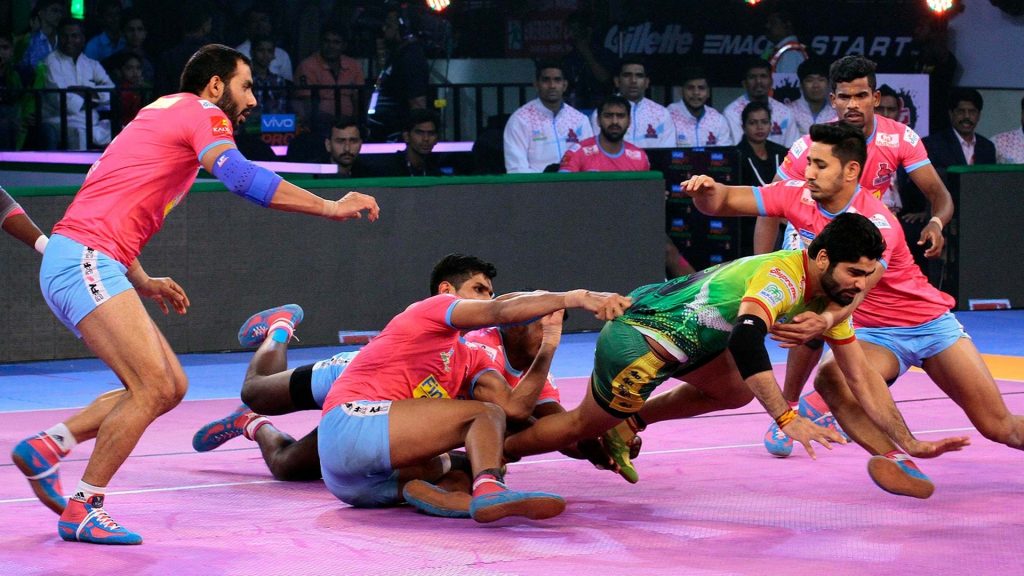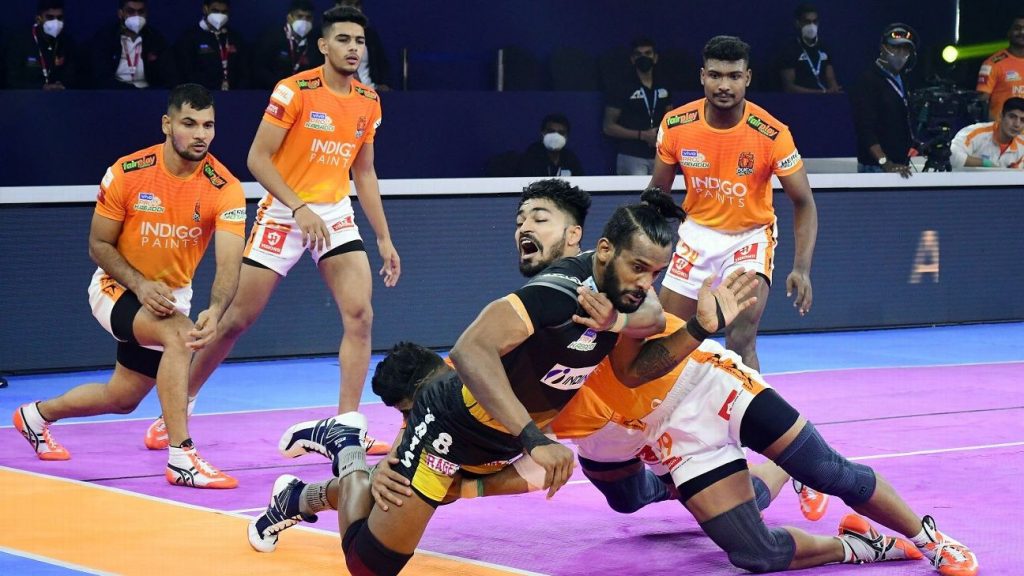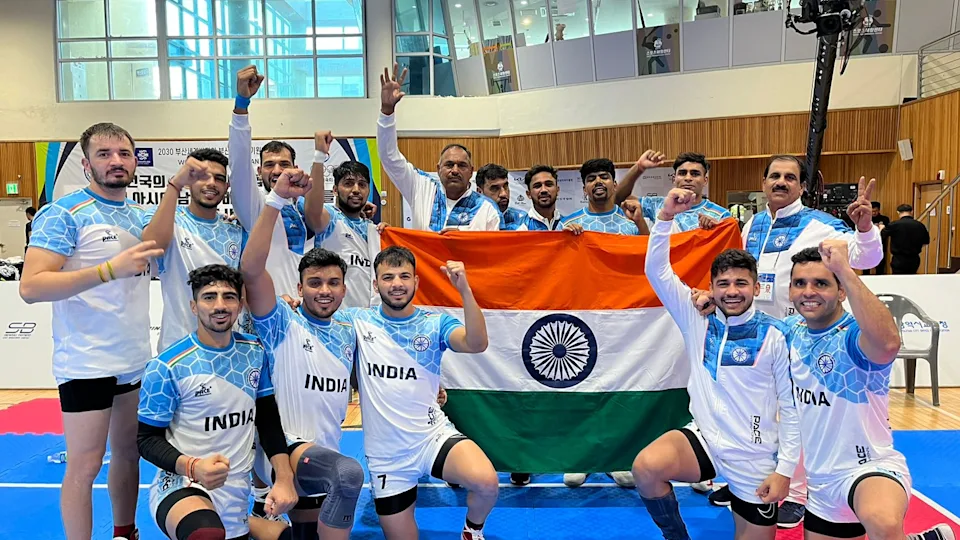During Kabaddi game two teams face off in a large square arena for two halves of 20 minutes each.
How Many Players in Kabaddi: Formats, Rules & Participants
Table of Contents
- 1 How Many Players in Kabaddi?
- 2 History of Kabaddi
- 3 Kabaddi Rules
- 4 Kabaddi Players Positions
- 5 How Many Players in Kabaddi One Side?
- 6 How Many Total Players in Kabaddi?
- 7 How Many Players Play in a Kabaddi Match?
- 8 How to Play Kabaddi?
- 9 How Points are Scored in Kabaddi?
- 10 Modernisation of Kabaddi Rules
- 11 International Kabaddi Competitions
- 12 Famous Kabaddi Teams and Players
- 13 Common Misconceptions About Kabaddi Team Composition
- 14 Frequently Asked Questions
How Many Players in Kabaddi?
Kabaddi is a team sport that originated in ancient India. The game is played between two teams of certain number of players. The objective of the game is to tag the opposing team’s players, known as raiders, and return to one’s own half of the court, without being tackled by the defenders. The game is popular among fand and bettors in India, Pakistan, Bangladesh, Sri Lanka, Nepal, and Iran.
History of Kabaddi
Kabaddi is a sport that has ancient roots and is still popular today. Its exact origin remains unknown, but it has been traced back to the 12th century, when references can be found in Indian religious epics like the Mahabharata. In India, it is traditionally played between two teams of seven players each. The game is centered around one player – the “raider” – who must enter the opposing team’s side of the court and tag as many members of the opposing team as possible before being tackled or taken out by members of that team.
The game has evolved throughout its history and gained popularity outside India in the early 20th century. One important moment in Kabaddi’s history was in 1918 when a national body called Amateur Kabaddi Federation of India (AKFI) was formed to oversee its growth and development. As a result, Kabaddi made its way into international competitions for the first time during the Asian Games held in New Delhi, India in 1938. Over time, national kabaddi federations have been established across Asia and Europe to promote Kabaddi on a larger scale.
Kabaddi became even more popular after it was featured on television for the first time when DD National broadcasted “The National Kabaddi Championship” from Chennai, India during 1989-90 season. The years that followed saw further growth with various countries hosting their own championships and leagues such as Pakistan Premier League (PPL), Tamil Nadu Premier League (TNPL) and USA Kabaddi League (USAKL).
Today, kabaddi enjoys tremendous following all over Asia and has also emerged as a major spectator sport in other parts of world including Europe and North America. In order to promote kabaddi globally, International Kabaddi Federation (IKF) was formed in 2004 which organizes several international tournaments such as World Cup Championship every four years since 2010 and Pro Kabaddi League which is currently sponsored by VIVO brand since 2014.
Thus far, over 70 countries are associated with IKF demonstrating its global reach and recognition across continents. With increased participation from different parts of world, kabaddi seems all set to become one of most popular sports alongside soccer and cricket very soon.
Kabaddi Rules
Kabaddi is a game that is played between two teams of seven players each. The object of the game is to score points by touching the opponents’ half of the court and returning to your own half, without being tackled. The team that scores the most points in the given time period (usually 20 minutes) wins the match.
Players can only take three steps forward before having to return to their half. If a player enters the other team’s half, they are out of the game. If a player is tackled, they are out of the game.
The game is played with a leather ball, which is passed from one player to another. The player who holds the ball cannot run, but must bounce or roll it to another player. Players cannot hold onto the ball for more than three seconds.
Kabaddi is a very physical game and players often get injured. There is a lot of running and tackling, so players need to be fit and agile.

Kabaddi Players Positions
There are seven positions in kabaddi: left raider, right raider, left cover, right cover, mid-cover, all-rounder, and defender. The left raider is responsible for raiding the opposite team’s side of the court, while the right raider does the same on the other side. The left and right covers protect their respective raiders, while the mid-cover moves around to help out. The all-rounder can perform any role as needed, while the defender stays in one place to guard the goal.
Kabaddi is a very strategic game, and each player’s position is critical to the success of the team. It takes a lot of practice and teamwork to be able to execute plays effectively and score points. In order to be a good raider, one must have quick reflexes and be able to think on their feet. A good cover needs to be strong and fast, able to stop the other team’s raiders from scoring. And finally, the all-rounder needs to be versatile and able to fill in wherever needed.
The defender is probably the most important player on the team, as they are responsible for keeping the other team from scoring. They need to be able to read the opponent’s movements and anticipate their next move. If they can do this, they can stop them from getting a point, or even better, catch them off guard and score a point for their own team!
How Many Players in Kabaddi One Side?
There are usually 7 players on each side of the court in Kabaddi. The objective of the game is for the raider to cross the line into the other half of the court, tag an opponent, and return to their own half without being tackled. If the raider is tackled, then they become ‘out’ and a new raider is sent into the game. The team with most players remaining at the final of the game wins.
How Many Total Players in Kabaddi?
Kabaddi is a popular sport in India. It is a contact sport that is played between two teams. Each team has 7 players. The objective of the game is to score points by touching the opposing team’s players and/or territory. The game is divided into two halves, each lasting 20 minutes. The team with the most points at the end of the match wins.

How Many Players Play in a Kabaddi Match?
Kabaddi is a team sport that is typically played by two teams of seven players. Each team has a raider and a defender. The raider tries to cross the line into the other team’s half and take out as many defenders as possible before returning to their own half. The defender’s goal is to stop the raider from crossing the line and taking them out. Typically, a kabaddi match lasts for 40 minutes, with a 10-minute break in the middle.
How to Play Kabaddi?
In kabaddi, two teams of seven players each face off against each other on opposite sides of the playing area. The goal is for one team to tag as many opponents as possible in a single raid, while the defending team tries to stop them.
The game of Kabaddi starts with a toss, with the winning team deciding whether to raid first or defend. After this, a raider from the raiding team enters the opponent’s half, shouting “Kabaddi, Kabaddi” continuously. The raider’s goal is to touch as many opposing team members as possible, and then return to their half of the court, without being tackled by the defenders.
This process of raiding and defending repeats until a team is declared the winner. The team with the most points at the end of the game wins. Points are awarded for successful raids (touching opponents without being caught) and successful tackles (stopping the raider from returning to their court).
It’s important to note that the raider should keep chanting “Kabaddi, Kabaddi” during the raid. If the raider takes a breath and stops chanting, it is considered a failed raid, and the defending team earns a point. This core rule of Kabaddi brings an additional layer of physical challenge and strategy, making the game incredibly exciting to play and watch.
How Points are Scored in Kabaddi?
Points are scored in kabaddi by either:
- Successful raids, where the raider touches opponents without being caught (1 point per touch)
- Successful tackles, when a defender stops the raider from returning to their court (2 points for each successful tackle).
Modernisation of Kabaddi Rules
Kabaddi has seen some changes in its rules over the years, modernising the sport and making it even more exciting.
One of these changes is the “do-or-die” rule which requires a raider to touch at least two members of their opponent’s team within 30 seconds or else they lose a point. This rule encourages players to be more aggressive and ambitious in their raiding tactics.
Another rule change is the introduction of a bonus line, which rewards teams for successful raids across the bonus/center line, awarding them an extra point. This encourages longer raids that put greater pressure on the defending team.
Finally, there have been some changes made to scoring tactics. Instead of allowing each team to score one point for every successful tackle, teams are now rewarded with two points for a successful tackle.
International Kabaddi Competitions
The International Kabaddi Federation (IKF) is the governing body for kabaddi. They oversee international tournaments, organize leagues and promote the game around the world.
The most prestigious event is Kabaddi World Cup, which was first held in 2004. The tournament features teams from countries all over Asia and Europe, with India winning 5 of the 8 World Cups held so far.
Other international competitions include the Asian Games and South Asian Games, which are held every two years. The Kabaddi Masters Tournament was first held in 2018, featuring some of the world’s best players from countries such as India, Pakistan, Bangladesh and many more.

Famous Kabaddi Teams and Players
Kabaddi has produced some of the world’s best players over the years. In India, Pro Kabaddi League (PKL) is the most popular kabaddi league in India. The PKL features some of the top domestic and international players, including:
- Pardeep Narwal (India)
- Ajay Thakur (India)
- Vishal Bhale (India)
- Abolfazl Maghsodloo (Iran)
- Tae Deok Ee (South Korea)
- Arun Kumar Vasudevan (Singapore).
These players have helped to shape the sport of kabaddi and are responsible for popularizing it globally.

Common Misconceptions About Kabaddi Team Composition
Kabaddi is often thought to be a game that requires physically strong players only, however this is not the case. Kabaddi involves many different skills, from agility and speed to strategy and teamwork. This makes it an incredibly exciting sport for all ages, genders and levels of physical skill.
Teams should be composed of a balanced mix of players, with different skill sets for different roles. This includes defenders who are strong and agile, as well as raiders who not only have speed but also good decision making skills.
Frequently Asked Questions
How many total players are in kabaddi?
Kabaddi is a team sport that is played indoors. There are two teams of seven players each.
How many extra players are in kabaddi?
Kabaddi is a sport that is played with two teams of seven players each. However, there are also variations of the game that allow for more players. Some versions of kabaddi have up to twelve players per team.
How many players play in Circle-style kabaddi?
In Circle-style kabaddi, the teams are made up of ten players each.


















